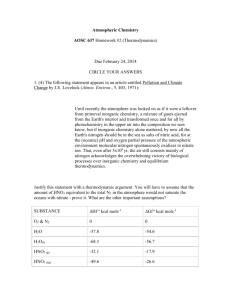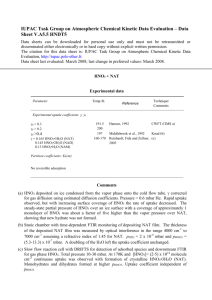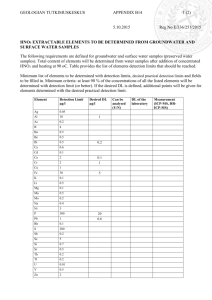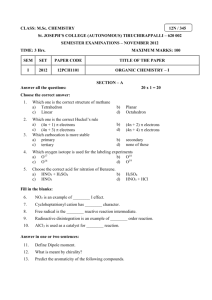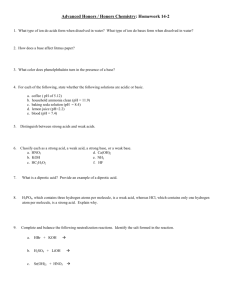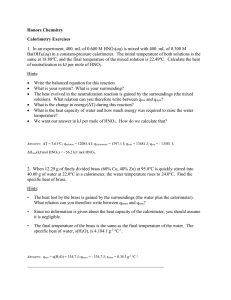Uptake of reactive nitrogen on cirrus cloud particles in the upper troposphere and lowermost stratosphere
advertisement
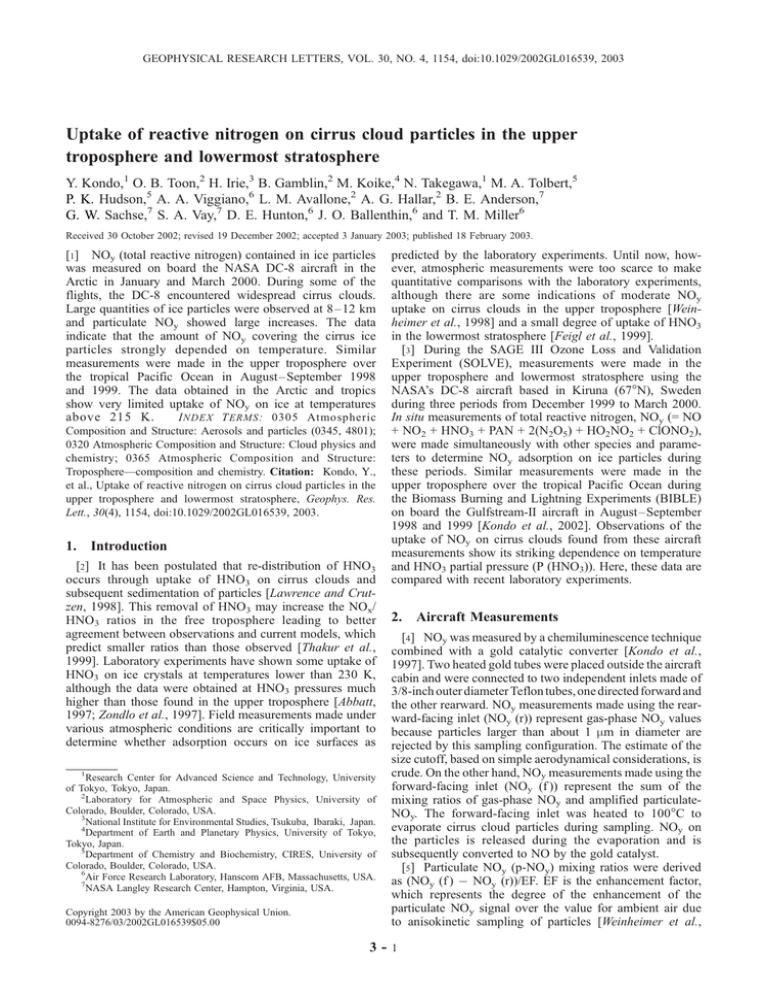
GEOPHYSICAL RESEARCH LETTERS, VOL. 30, NO. 4, 1154, doi:10.1029/2002GL016539, 2003 Uptake of reactive nitrogen on cirrus cloud particles in the upper troposphere and lowermost stratosphere Y. Kondo,1 O. B. Toon,2 H. Irie,3 B. Gamblin,2 M. Koike,4 N. Takegawa,1 M. A. Tolbert,5 P. K. Hudson,5 A. A. Viggiano,6 L. M. Avallone,2 A. G. Hallar,2 B. E. Anderson,7 G. W. Sachse,7 S. A. Vay,7 D. E. Hunton,6 J. O. Ballenthin,6 and T. M. Miller6 Received 30 October 2002; revised 19 December 2002; accepted 3 January 2003; published 18 February 2003. [1] NOy (total reactive nitrogen) contained in ice particles was measured on board the NASA DC-8 aircraft in the Arctic in January and March 2000. During some of the flights, the DC-8 encountered widespread cirrus clouds. Large quantities of ice particles were observed at 8 –12 km and particulate NOy showed large increases. The data indicate that the amount of NOy covering the cirrus ice particles strongly depended on temperature. Similar measurements were made in the upper troposphere over the tropical Pacific Ocean in August – September 1998 and 1999. The data obtained in the Arctic and tropics show very limited uptake of NOy on ice at temperatures I NDEX T ERMS : 0305 Atmospheric above 215 K. Composition and Structure: Aerosols and particles (0345, 4801); 0320 Atmospheric Composition and Structure: Cloud physics and chemistry; 0365 Atmospheric Composition and Structure: Troposphere—composition and chemistry. Citation: Kondo, Y., et al., Uptake of reactive nitrogen on cirrus cloud particles in the upper troposphere and lowermost stratosphere, Geophys. Res. Lett., 30(4), 1154, doi:10.1029/2002GL016539, 2003. 1. Introduction [2] It has been postulated that re-distribution of HNO3 occurs through uptake of HNO3 on cirrus clouds and subsequent sedimentation of particles [Lawrence and Crutzen, 1998]. This removal of HNO3 may increase the NOx/ HNO3 ratios in the free troposphere leading to better agreement between observations and current models, which predict smaller ratios than those observed [Thakur et al., 1999]. Laboratory experiments have shown some uptake of HNO3 on ice crystals at temperatures lower than 230 K, although the data were obtained at HNO3 pressures much higher than those found in the upper troposphere [Abbatt, 1997; Zondlo et al., 1997]. Field measurements made under various atmospheric conditions are critically important to determine whether adsorption occurs on ice surfaces as 1 Research Center for Advanced Science and Technology, University of Tokyo, Tokyo, Japan. 2 Laboratory for Atmospheric and Space Physics, University of Colorado, Boulder, Colorado, USA. 3 National Institute for Environmental Studies, Tsukuba, Ibaraki, Japan. 4 Department of Earth and Planetary Physics, University of Tokyo, Tokyo, Japan. 5 Department of Chemistry and Biochemistry, CIRES, University of Colorado, Boulder, Colorado, USA. 6 Air Force Research Laboratory, Hanscom AFB, Massachusetts, USA. 7 NASA Langley Research Center, Hampton, Virginia, USA. Copyright 2003 by the American Geophysical Union. 0094-8276/03/2002GL016539$05.00 predicted by the laboratory experiments. Until now, however, atmospheric measurements were too scarce to make quantitative comparisons with the laboratory experiments, although there are some indications of moderate NOy uptake on cirrus clouds in the upper troposphere [Weinheimer et al., 1998] and a small degree of uptake of HNO3 in the lowermost stratosphere [Feigl et al., 1999]. [3] During the SAGE III Ozone Loss and Validation Experiment (SOLVE), measurements were made in the upper troposphere and lowermost stratosphere using the NASA’s DC-8 aircraft based in Kiruna (67N), Sweden during three periods from December 1999 to March 2000. In situ measurements of total reactive nitrogen, NOy (= NO + NO2 + HNO3 + PAN + 2(N2O5) + HO2NO2 + ClONO2), were made simultaneously with other species and parameters to determine NOy adsorption on ice particles during these periods. Similar measurements were made in the upper troposphere over the tropical Pacific Ocean during the Biomass Burning and Lightning Experiments (BIBLE) on board the Gulfstream-II aircraft in August –September 1998 and 1999 [Kondo et al., 2002]. Observations of the uptake of NOy on cirrus clouds found from these aircraft measurements show its striking dependence on temperature and HNO3 partial pressure (P (HNO3)). Here, these data are compared with recent laboratory experiments. 2. Aircraft Measurements [4] NOy was measured by a chemiluminescence technique combined with a gold catalytic converter [Kondo et al., 1997]. Two heated gold tubes were placed outside the aircraft cabin and were connected to two independent inlets made of 3/8-inch outer diameter Teflon tubes, one directed forward and the other rearward. NOy measurements made using the rearward-facing inlet (NOy (r)) represent gas-phase NOy values because particles larger than about 1 mm in diameter are rejected by this sampling configuration. The estimate of the size cutoff, based on simple aerodynamical considerations, is crude. On the other hand, NOy measurements made using the forward-facing inlet (NOy (f )) represent the sum of the mixing ratios of gas-phase NOy and amplified particulateNOy. The forward-facing inlet was heated to 100C to evaporate cirrus cloud particles during sampling. NOy on the particles is released during the evaporation and is subsequently converted to NO by the gold catalyst. [5] Particulate NOy (p-NOy) mixing ratios were derived as (NOy (f ) NOy (r))/EF. EF is the enhancement factor, which represents the degree of the enhancement of the particulate NOy signal over the value for ambient air due to anisokinetic sampling of particles [Weinheimer et al., 3-1 3-2 KONDO ET AL.: CLOUD PARTICLE UPTAKE OF REACTIVE NITROGEN 1998; Feigl et al., 1999]. The enhancement of individual particles depends on the ratio of the true air speed to the flow speed and the Stokes parameter, and therefore depends on the size of the particles in a strict sense. The EF was approximated using a simple model assuming that the inlet system consists of only the Teflon tube. At the particle diameters of 5 and 10 mm, the calculated EF values reach 90 and 100% of the maximum EF value, given as the ratio of the true air speed to the flow speed inside the inlet tube. Because cirrus cloud particles were generally larger than 10 mm, as shown below, the maximum EF values were used for the present analysis. The EF is calculated to be about 120 at 200 hPa for typical DC-8 cruising speeds. [6] For this analysis, we used gas-phase HNO3 mixing ratios measured by the Chemical Ionization Mass Spectrometer (CIMS) [Ballenthin et al., 2003] to derive average HNO3/NOy ratios during SOLVE. Aerosol size distributions for diameters of up to 20 mm were measured by the Forward Scattering Spectrometer Probe (FSSP)-300 every 10 s. H2O mixing ratios were observed with a near-IR tunable Diode Laser Hygrometer (DLH) mounted on the DC-8 [Vay et al., 1998]. This external path instrument provides accurate water vapor measurements both in cloud-free conditions and within clouds. The total water content (gas-phase H2O + particulate H2O) was obtained by sampling air from a forward-facing inlet, similar to NOy (f ), combined with a closed-path laser hygrometer (CLH), part of the TOTCAP instrument package (L. Avallone, University of Colorado, unpublished data, 2002). H2O amounts in cirrus cloud particles were derived by subtracting the gas-phase H2O values and dividing by the EF of the water inlet, which was about 50 at 200 hPa for DC-8 cruising speeds. During BIBLE, spectra of aerosol concentrations over the diameter range of 0.3– 40 mm were measured by the Multiangle Aerosol Spectrometer Probe (MASP) [Baumgardner and Gandrud, 1998; Liley et al., 2002]. 3. Results and Discussion [7] The most extensive cirrus clouds in the upper troposphere were encountered over eastern Greenland, the Scandinavian Peninsula, and north-western Russia, during the flights from Kiruna on January 23, 25, and March 8, 2000. The data obtained on these days constitute 90% of the cirrus cloud data obtained during the whole SOLVE periods. Time series plots of the data obtained on January 23 are shown in Figure 1. TNAT (the temperature below which nitric acid trihydrate (NAT: HNO33H2O) would be stable) and TICE (ice saturation temperature) are also shown in this figure. Encounters with widespread cirrus clouds are identified by the enhancements in the surface areas (SAs) at 29,000 – 35,000 UT s and 51,000– 60,000 UT s. [8] The SA was obtained by integrating the differential surface area in each 1-mm size bin. However, because the upper size limit of the FSSP-300 is only 20 mm, it does not include a significant fraction of the particle size distribution. FSSP-300 underpredicts particulate H2O volume, as measured by CLH, by a nonconstant factor near 5 during SOLVE. In previous studies, there were instances where the FSSP surface area was measured to be low by factors of 4 – 10 [Heymsfield and McFarquhar, 1996]. There may well be a long tail of particles extending beyond 20 mm. The SA beyond 20 mm was estimated using the number density measured by the FSSP-300 and the total volume of partic- Figure 1. Time series plots of the sampling altitude, ambient temperatures, threshold temperatures for ice (TICE) and NAT (TNAT), O3 mixing ratios, surface area (SA), and gas-phase NOy and total NOy (gas-phase NOy + amplified particulate-NOy). The temperatures during most of the cloud encounters are higher than TICE by about 1 K, which is within the error of the temperature measurements. ulate H2O, assuming a log-normal size distribution. The inclusion of SAs beyond 20 mm increased the total SA values by a factor of about 2, on average. However, the particulate H2O volume could still be an underestimate, considering the configuration of the sampling system. It is therefore reasonable to consider the SAs derived from the FSSP-300 and particulate H2O data to be an underestimate. [9] Cirrus cloud particles were observed when the relative humidity with respect to ice (RHI) was 100 ± 15% at temperatures of 197– 210 K during SOLVE. It is very likely these large particles observed below 230 K were made of ice, considering that these particles were often encountered when RHI was near 100% [Jensen et al., 2001]. [10] Enhanced p-NOy values were associated with the encounters with the cirrus clouds above 10 km. The p-NOy values were correlated with the SA at temperatures lower than 215 K, indicating adsorption of NOy on ice (not shown). We have no direct evidence that the condensing species is actually nitric acid, as opposed to one of the other components of NOy. However, laboratory data discussed below is clearly consistent with nitric acid condensation. In most cases, cirrus clouds were encountered in the upper troposphere where the O3 mixing ratios were lower than 100 ppbv, although in some cases the O3 values reached 200 ppbv. [11] The SA, p-NOy (non-amplified), total HNO3 (gasphase HNO3 + p-NOy), and F (p-NOy/total HNO3) observed above 8 km during the whole SOLVE periods are plotted versus temperature in Figure 2, together with the median values derived using the data for SA larger than 100 mm2 KONDO ET AL.: CLOUD PARTICLE UPTAKE OF REACTIVE NITROGEN Figure 2. SA, p-NOy, total HNO3 (gas-phase HNO3 + pNOy), and F (p-NOy/total HNO3) versus the temperature. Median values corresponding to the data for SA > 100 mm2 cm 3 are shown as squares. cm 3. In this study, the gas-phase HNO3 mixing ratios were estimated from the observed NOy mixing ratios and average HNO3/NOy ratios as a function of the O3 mixing ratio because of occasional lack of the CIMS HNO3 data. The average HNO3/NOy ratios were about 0.4 ± 0.2 for 40 < O3 < 100 ppbv and increased to close to unity for O3 > 300 ppbv. These ratios are similar to those observed above 8 km north of 40N in early spring [Kondo et al., 1997]. [12] Enhancements of SA were observed in a wide temperature range between 197 and 250 K. A striking temperature dependence of the p-NOy values is readily seen in Figure 2.The fraction of the nitric acid on the ice, F, also increased with the decrease in temperature below 215 K. The median values ranged between 0.15 and 0.4 in this temperature range. The median value of F at temperatures below 215 K was 0.24 ± 0.2, independent of the ranges of SA, namely, for SA > 100, 100 < SA < 400, 400 < SA < 600, and SA > 600 mm2 cm 3. [13] The number of NOy molecules adsorbed on ice per unit surface area (NOy coverage) is given by the ratio pNOy/SA. The data obtained at SA larger than 100 mm2 cm 3 were used for the present analysis to select typical cirrus cloud data. The temperatures in cirrus clouds were generally higher than TNAT, which was lower than TICE in most cases in the troposphere (Figure 1). On some occasions when the temperature was close to or lower than TNAT, adsorption of HNO3 into super-cooled ternary solution (STS) particles was predicted according to a liquid ternary aerosol model [Lin and Tabazadeh, 2001]. The data at temperatures lower than TNAT + 2 K were excluded from the present analysis to eliminate the STS particles as a reservoir for nitric acid. [14] The median NOy coverage is plotted versus temperature in Figure 3. Because the HNO3 coverage on ice is predicted to be a function of temperature and P (HNO3) [Tabazadeh et al., 1999; Hudson et al., 2002], the P (HNO3) 3-3 value is also shown in this figure. Cirrus clouds were sometimes encountered in the upper troposphere over the tropical Pacific Ocean during the BIBLE aircraft measurements. The HNO3 coverage on these cirrus clouds was derived in a similar way to that for the SOLVE data. The gas-phase NOy mixing ratios were derived as NOy NOx mixing ratios. NOx and HNO3 were found to be the major components of NOy by the previous observations in the tropical upper troposphere [Kondo et al., 1997]. The resulting median HNO3/NOy ratios were about 0.5– 0.65. Generally, the NOy mixing ratios were very low at 13 km (atmospheric pressure of 150 hPa) over the tropical Pacific Ocean. The estimated P (HNO3) was as low as 0.5 10 8 hPa (Figure 3). [15] It can be seen in Figure 3 that the NOy coverage observed during SOLVE sharply increased at temperatures lower than 215 K, as expected from the temperature dependence of p-NOy (Figure 2). The coverage is 0.4 –1.6 1014 NOy molecules cm 2 at P (HNO3) = 1 – 4 10 8 hPa and 200 K < T < 210 K, with typical values at O3 lower than 100 ppbv. The data at P (HNO3) = 2.3 10 7 hPa and 210 K, obtained in the lowermost stratosphere, is shown separately for the sake of clarity. [16] During BIBLE, the NOy coverage was as low as 1 – 5 1012 molecules cm 2 even at temperatures of 210 K, corresponding to the low P (HNO3) values, as shown in Figure 3. The dependence of the NOy coverage on P (HNO3) at 210 K is shown in Figure 4 more directly. The coverage shows a systematic increase in the P (HNO3) range from 5 10 9 to 2 10 7 hPa. [17] Uptake of HNO3 on ice has been measured in the laboratory at temperatures between 208 – 248 K but with P (HNO3) of 1 10 7 – 4 10 6 hPa [Abbatt, 1997], which are much higher than those observed in the upper troposphere. Uptake of HNO3 on ice was also measured at 211 K at HNO3 pressures of 10 8 – 10 6 hPa [Zondlo et al., 1997]. These data were used to construct a Langmuir model, which describes the formation of a monolayer as a function of temperature and P (HNO3) [Tabazadeh et al., 1999]. [18] Recent HNO3 uptake data from laboratory experiments [Hudson et al., 2002] have shown marked differences Figure 3. Observed NOy coverage on ice versus temperature. SOLVE (circles) and BIBLE (triangles and squares) data are shown together with the HNO3 partial pressures (P(HNO3)). The HNO3 coverage values calculated by the FHH model at P(HNO3) = 1, 4, and 23 10 8 hPa (lines) are shown for comparison. 3-4 KONDO ET AL.: CLOUD PARTICLE UPTAKE OF REACTIVE NITROGEN of the particles. However, it may alter the chemical reactivity of the surfaces. The present study suggests that this effect, if it does occur, will be most important in the coldest part of the upper troposphere. [23] Acknowledgments. This work was supported by the SOLVE program at NASA. References Figure 4. Observed NOy coverage on ice at 210 ± 5 K versus the HNO3 partial pressures. The data points are plotted for the median P(HNO3) values. HNO3 coverage values calculated by the FHH model at 205, 210, and 215 K (lines) are shown for comparison. from previous ones [Abbatt, 1997; Zondlo et al., 1997]. The HNO3 coverage has been derived from the amount of HNO3 adsorbed on a thin ice film. The equilibrium HNO3 uptake increases markedly at temperatures lower than 215 K, similar to the present observations. The equilibrium coverage has been expressed by a Frenkel-Halsey-Hill (FHH) model as a function of temperature (T) and P (HNO3) [Hudson et al., 2002]. The model values as a function of T are shown in Figure 3, for selected P (HNO3) values, for comparison with the observed uptake values. The sharp increase in coverage at 215 K is well represented by the FHH model, although the model values are considerably lower than those observed at corresponding P (HNO3) values. The Langmuir model does not predict this strong temperature dependence. [19] Comparison of the FHH model with observations at 210 K is also shown in Figure 4. Although the FHH model predicts an increase of the coverage with the increase in P (HNO3), the model values are lower than the observations at P (HNO3) = 0.2 and 2 10 7 hPa by a factor of 4, while they are higher than the observations for pressures below 10 8 hPa. These differences could be due to systematic uncertainties in the measurements of the SA values. [20] The HNO3 adsorption can exceed 1 1014 HNO3 molecules cm 2 only at temperatures below 210 K. This suggests that conditions for significant re-distribution of HNO3 via ice cloud particle precipitation can be fulfilled only within the cold upper troposphere. At these temperatures, uptake on ice can deplete 15 –40% of the ambient gasphase NOy, depending on temperature, surface area, and exposure time. [21] As cirrus clouds sediment, the coverage is significantly reduced due to the increase in the temperature. At temperatures higher than 215 K, the coverage is down to about 1 – 5 1012 HNO3 molecules cm 2. This low coverage will prevent effective redistribution of NOy below 8 km, where temperatures are generally higher than 215 K. [22] The sub-monolayer coverage of cirrus cloud particles with NOy is not likely to change the optical properties Abbatt, J. P. D., Interaction of HNO3 with water-ice surfaces at temperatures of the free troposphere, Geophys. Res. Lett., 24, 1479 – 1482, 1997. Ballenthin, J. O., et al., In situ HNO3 to NOy instrument comparison during SOLVE, J. Geophys. Res., 108, doi:10.1029/2002JD002136, in press, 2003. Baumgardner, D., and B. E. Gandrud, A comparison of the microphysical and optical properties of particles in an aircraft contrail and mountain wave cloud, Geophys. Res. Lett., 25, 1129 – 1132, 1998. Feigl, C., et al., Observation of NOy uptake by particles in the Arctic tropopause region at low temperatures, Geophys. Res. Lett., 26, 2215 – 2218, 1999. Heymsfield, A. J., and G. M. McFarquhar, High albedos of cirrus in the tropical pacific warm pool: Microphysical interpretations from CEPEX and from Kwajalein, Marshall islands, J. Atmos. Sci., 53, 2424 – 2451, 1996. Hudson, P. K., et al., Uptake of nitric acid on ice at tropospheric temperatures: Implications for cirrus clouds, J. Phys. Chem. A., 106, 9874 – 9882, 2002. Jensen, E. J., et al., Prevalence of ice-supersaturated regions in the upper troposphere: Implications for optically thin ice cloud formation, J. Geophys. Res., 106, 17,253 – 17,266, 2001. Kondo, Y., et al., Profiles and partitioning of reactive nitrogen over the Pacific Ocean in winter and early spring, J. Geophys. Res., 102, 28,405 – 28,424, 1997. Kondo, Y., et al., Effects of biomass burning, lightning, and convection on O3, CO, and NOy over the tropical Pacific and Australia in August – October 1998 and 1999, J. Geophys. Res., 107, 8402, doi:10.1029/ 2001JD000820, 2002. Lawrence, M. G., and P. J. Crutzen, The impact of cloud particle gravitational settling on soluble trace gas distributions, Tellus, Ser. B, 50, 263 – 289, 1998. Liley, J. B., et al., Black carbon in aerosol during BIBLE-B, J. Geophys. Res., 107, 8399, doi:10.1029/2001JD000845, 2002. Lin, J.-S., and A. Tabazadeh, A parameterization of an aerosol physical chemistry model for the NH3/H2SO4/HNO3/H2O system at cold temperatures, J. Geophys. Res., 106, 4815 – 4829, 2001. Tabazadeh, A., et al., A surface chemistry model for nonreactive trace gas adsorption on ice: Implications for nitric acid scavenging by cirrus, Geophys. Res. Lett., 26, 2211 – 2214, 1999. Thakur, A. N., et al., Distribution of reactive nitrogen species in the remote free troposphere: Data and model comparisons, Atmos. Environ., 33, 1403 – 1422, 1999. Vay, S. A., et al., DC-8-based observations of aircraft CO, CH4, N2O, and H2O(g) emission indices during SUCCESS, Geophys. Res. Lett., 25, 1717 – 1720, 1998. Weinheimer, A. J., et al., Uptake of NOy on wave-cloud ice particles, Geophys. Res. Lett., 25, 1725 – 1728, 1998. Zondlo, M. A., et al., Uptake of HNO3 on ice under upper tropospheric conditions, Geophys. Res. Lett., 24, 1391 – 1394, 1997. B. E. Anderson and G. W. Sachse, Atmospheric Sciences Division, NASA Langley Research Center, Hampton, VA 23681, USA. L. M. Avallone, B. Gamblin, A. G. Hallar, and O. B. Toon, Laboratory for Atmospheric and Space Physics, University of Colorado, Boulder, CO 80309-0392, USA. J. O. Ballenthin, D. E. Hunton, T. M. Miller, and A. A. Viggiano, Air Force Research Laboratory/VSBXT, 29 Randolph Rd, Hanscom AFB, MA 01731-3010, USA. P. K. Hudson and M. A. Tolbert, Department of Chemistry and Biochemistry, CIRES, University of Colorado, Boulder, CO 80309, USA. H. Irie, National Institute for Environmental Studies, Tsukuba, Ibaraki, 305-0053, Japan. M. Koike, Department of Earth and Planetary Physics, University of Tokyo, Tokyo 113-0033, Japan. Y. Kondo and N. Takegawa, Research Center for Advanced Science and Technology, University of Tokyo, Tokyo 153-8904, Japan. (kondo@ atmos.rcast.u-tokyo.ac.jp)
